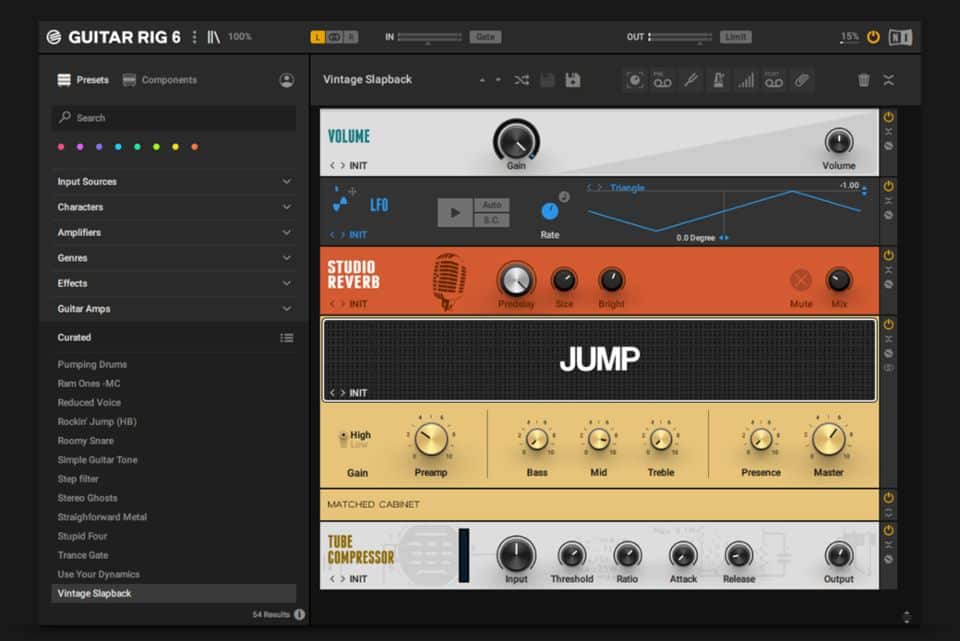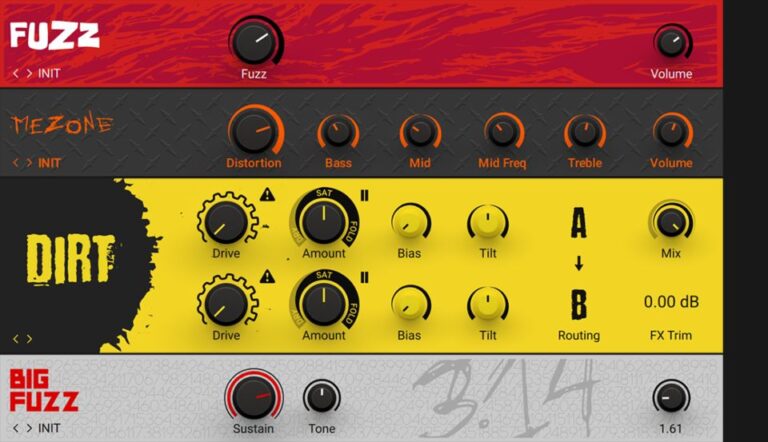Last Updated on January 4, 2024 by IDS Team
Ok, so this COULD just be another Guitar Rig 6 Pro review. There are a LOT of reviews of Guitar Rig 6 by Native Instruments out there as well as detailed comparisons with other amp sims such as Helix Native and AmpliTube, such as our detailed breakdown here.
However, with the latest update Guitar Rig 7 – and the first in 3 years – we decide to take a look here at what exactly separates Guitar Rig from it’s competitors, how it differs, where it falls short, and more . Hopefully, this guide will break down who exactly it that the Guitar Rig series might work for, what alternatives there are, and a no-holds-barred look at how you might use it in your playing, so read on.
Guitar Rig Pro General Audience
The Guitar Rig Pro vs Player vs Helix Native, AmpliTube and other amp sims debate has been going on ever since Guitar Rig launched over 5 years ago now. This is pretty classic software and didn’t change much between its initial version and Guiar Rig 6. For an honest Guitar Rig 6 review in more detail, click here. However, in short, it aims mostly at giving you the broadest variety of amps and cabinets possible whilst not breaking the bank and offering a smooth and modern interface.
You can get Guitar Rig 6 Pro from Native Instruments’ website by (and if you buy using our link we get a small kickback so you will be helping our website).
What Is Guitar Rig 6 (and now 7!) missing?
- 8 track mixer – simply put, competitor Amplitube has more tools for intuitive production while not leaving this VST
- Super accurate sound – Helix Native sound quality and uniqueness has an edge over Guitar Rig. Amplitube’s new TONEX capabilities also give you more options to use custom amps, cabs, and plugins
However, it is still really good! And it has some production tools of its own, which if you like them a lot, make it very worthwhile:
- The new iteration of Guitar Rig (Guitar Rig 7) adds the ozone maximizer and impulse response loader.
- The first is a powerful limiter that adds a boost of production capability to what is otherwise an amp sim.
- The second allows you to control IRs with options like high cut and low cut filters, letting you scult sonic changes as if in a real studio. However, it lacks the intuitiveness of Amplitube’s mic placement feature.
- New LOFI FX bundle gives you unique features like vibrato, noise machine, and tape wobble
- Guitar Rig 7 update also comes with a new loop machine
Is Guitar Rig 6 Just a Basic or Beginner-Friendly Amp Sim?
The short answer is yes and no. While Guitar Rig 6 isn’t as high-end as Helix native it still isn’t something to laugh at with a relatively decent feature count and 13 FX even at the free level.
Why Guitar Rig 6 Pro AND Player are Best for Home Recording
The ability to mix, match and modify the whole FX chain is also a winner that it shares with its competitors but in a simpler and more streamlined style.
The simplicity and classic focus of the Guitar Rig series is basically everything you need to get started with home recording. With the other options on this list, there may be extra features that aren’t worth it if you have access to a studio or hardware guitar gear.
vs Player
The Pro vs Player debate really just boils down to whether you need to pay the full cost for Guitar Rig 6 Pro. The obvious benefit is that if you opt for Player you can test it out to see if you like the general guitar rig software and then use that to help your decision between pro and whoever other amp sim you are considering. How much guitar will you actually be using?
Pro is simply a paid-for version of Player that has more features. Ampos and FX skew towards classic rock, pop, and other guitar-based genres like indie and punk. There are also jazz tones and classic effects like fuzz and phaser.

That being said, Player is relatively basic compared to other contenders and does not have as many FX. It only offers one cabinet, in practice it works a bit more like a pedalboard than a full-fledged amp sim. However, it’s worth it if you want to decide between Guitar Rig 6 and Amplitube, for example, as both have their free versions.
Guitar Rig 6 vs Amplitube: Does it Stand Up For Audiophiles?
The ONE downside of Guitar Rig 6 compared to something like Amplitube, apart from the detail levels, is that Amplitube has a real edge with its VIR technology. This models the sound of actual amps in a non-linear way, capturing the nuance and individuality of classic amps by brands such as Orange and Mesa Boogie.
Whilst Helix Native pays attention to high-end sound quality, Guitar Rig uses ICM (intelligent circuit modelling) tech to faithfully recreate each component of your favorite amps and FX pedals.
Although this makes them very accurate, Amplitube also has this feature – and goes further with its VIR which allows you to control tone much more with features like mic placement and a much more granular detail level regarding its IRs.
You can get Amplitube on the IK Multimedia website by .
The Amplitube 8 Track Recorder and Mixer: is AmpliTube Worth it Because Of This Feature?
There are a lot of articles already giving you a Guitar Rig 6 review in comparison, and mentioning how great the Amplitube 8 track recorder and mixer is. Yes, it is a brilliant feature and done really well, but it raises one question: is it really necessary if you already have a DAW?
Ultimately it depends on how much you care about convenience. If you don’t want everything in one place, it isn’t such a feature. But if you’re a producer, and combined with all the other features of Amplitube such as the VIR technology, it is worth it if you want to have a holistic look at your mix in one go and make the changes you need.
Another benefit Amplitube 5 is that it DOES come with an app for iPhone and iPad. In this way you can record guitar on the go, turning your phone into a portable DAW or ‘tone studio’. This DOES give it an edge over Guitar Rig 6 because it means if you have an idea or experiment that you want to try out on the go… you can.
However, if you already have a confident home studio setup, you may not need this feature as much.
Guitar Rig 6 vs Helix Native: The Audiophile’s Choice
At the most basic level, Helix Native is a high-end industry-leading amp sim designed for professional musicians recording full albums hence the higher price. Sound quality is top notch and it allows you to record unprocessed guitar that you can play with to your heart’s content afterwards. It allows hyper-detailed control over impulse responses and you can even load new ones. Thus, it’s best for audiophiles who don’t mind if it’s slightly less intuitive.
Is Helix Native Worth it Compared to Guitar Rig 6?
One potential benefit of Helix Native is that the FX such as reverbs, delays, and even pedals are more creative and nuanced, there’s marginally more variety and diversity, and they’re slightly more skewed towards musicians who want to push their sound.
If you’re looking for MORE than just classic sounds and want something a bit more out of the box, Helix Native is the one to go for. For high quality and uniqueness, it can’t be beat.
With the new Guitar Rig 7 update, if you want some smart production tools and an interesting range of gear, but are willing to sacrifice a little bit of realistic detail in terms of sound, this may be your best choice instead.
How To Decide Between Different Amp Sims
There are so many Guitar Rig 6 review articles breaking down the specific specs of these amp sims without looking at how they work in reality. As a result, we have done a bit of research to see how the different options available work regards your individual situation.
GUITAR LEVEL:
Are you a beginner or a more experienced guitarist? It may not sound like it matters with an amp sim but if you are just starting and want to record yourself, Guitar Rig 6 has more than enough options without breaking the bank. It is also infinitely more beginner-friendly as at this stage you may not be able to fully exploit the quality or range of options Helix Native has to offer.
PRODUCTION LEVEL:
Like your playing level, this is even more important to consider as it’s crucial to getting the best sounds out of any amp sim. Great equipment can only go so far, if you’re not fully confident on how to use a more complex amp sim having better gear won’t make your tracks sound better. Either way all three options are very intuitive and help visually represent the signal chain.
That said, the new Guitar Rig 7 update has a LOT of great stuff for producers such as the LoFi FX bundle that offers analog warmth and the tonal control of real-life recording. It’s features like these that make all these amp sims a lot more than just that – but for interesting quirks and production versatility with the new update, Guitar Rig may sometimes have an edge despite its other shortcomings.
GENRE:
There are MANY pop, hip-hop, indie, alternative, synthpop, post-punk, and electronic producers who still use a bit of guitar in their music now and then. The key question is how much will you be using guitar? If you are playing a guitar-heavy genre like metal, punk, indie rock, or hard rock, then Helix Native may be the option for you – or Amplitube for the greater control and diversity it offers.
However, if you’re looking for an amp sim simply to add a bit of guitar into tracks of a genre that doesn’t heavily use it, AmpliTube or Guitar Rig 6 is the way to go. Simply put, Helix Native is an amazing amp sim but won’t be worth it if you intend to mix your guitar sounds into another genre where they will interact with lots of effects. However, if guitar is to be center stage, helix native is definitely worth considering.
GEAR SETUP:
Ok, so who wouldn’t want over 400+ FX, pedals, and other options for your guitar? All of these are essentially tone modeling studios, but whether you go for a fuller or more basic option will depend on how much analog gear you have and how satisfied you are with it. If you’ve already found your sound and are playing something pretty stripped back with a few hardware amps you may not want as many of the features on offer with these amo sims in which case it makes sense to go for the most basic.
However, even at the free level, sims like Guitar Rig 6 and Amplitube are LIFESAVERS when it comes to providing creative sounds for bedroom musicians on a budget.
Bottom Line
In the end, there is no strict hierarchy of ‘which is better’ when it comes to amp sims. There are many musicians who find Helix Native to sound more realistic. Ultimately though, it depends on your purposes. Ifyou aren’t necessarily going to use all the FX a particular sim has to offer, then it makes sense to opt for a more basic option.
There’s also the fact that limitations can stimulate creativity.
However, a more basic amp sim like Guitar Rig now comes with more production-oriented detail. thus, it can be a good middle ground if you want something to cut your teeth on as a new producer and/or guitarist.If you found this useful to help distinguish what amp sim is right for you, we have many more comparisons in our reviews section here. In addition, if you simply love reading about VSTs in-depth and checking out new software, take a look at our software section.



